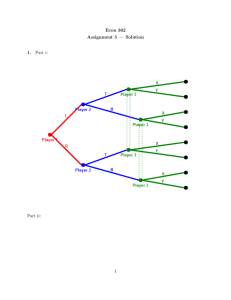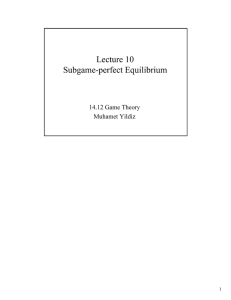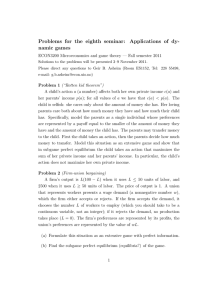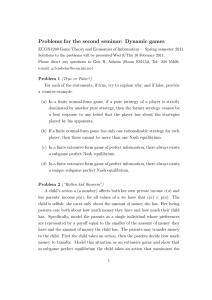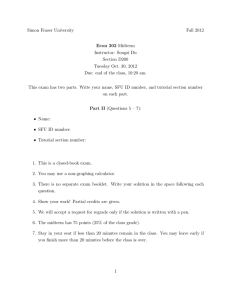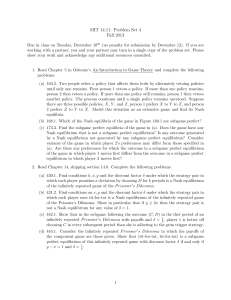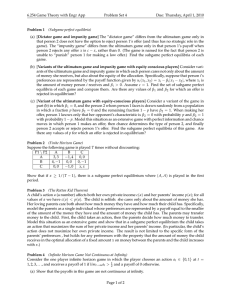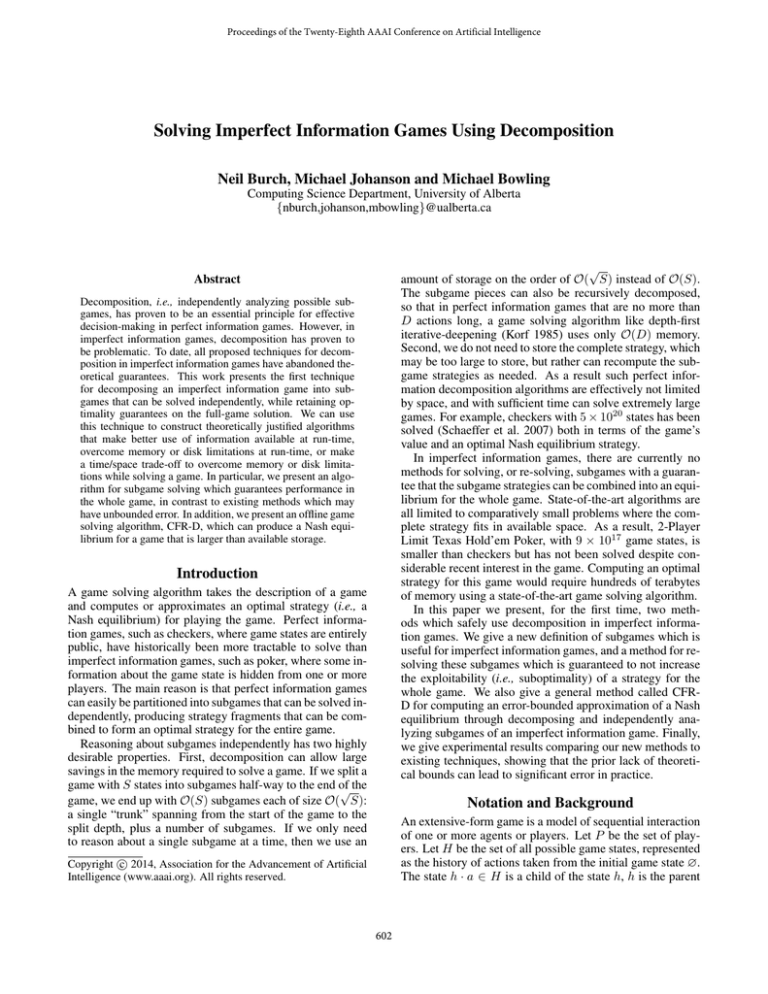
Proceedings of the Twenty-Eighth AAAI Conference on Artificial Intelligence
Solving Imperfect Information Games Using Decomposition
Neil Burch, Michael Johanson and Michael Bowling
Computing Science Department, University of Alberta
{nburch,johanson,mbowling}@ualberta.ca
√
amount of storage on the order of O( S) instead of O(S).
The subgame pieces can also be recursively decomposed,
so that in perfect information games that are no more than
D actions long, a game solving algorithm like depth-first
iterative-deepening (Korf 1985) uses only O(D) memory.
Second, we do not need to store the complete strategy, which
may be too large to store, but rather can recompute the subgame strategies as needed. As a result such perfect information decomposition algorithms are effectively not limited
by space, and with sufficient time can solve extremely large
games. For example, checkers with 5 × 1020 states has been
solved (Schaeffer et al. 2007) both in terms of the game’s
value and an optimal Nash equilibrium strategy.
In imperfect information games, there are currently no
methods for solving, or re-solving, subgames with a guarantee that the subgame strategies can be combined into an equilibrium for the whole game. State-of-the-art algorithms are
all limited to comparatively small problems where the complete strategy fits in available space. As a result, 2-Player
Limit Texas Hold’em Poker, with 9 × 1017 game states, is
smaller than checkers but has not been solved despite considerable recent interest in the game. Computing an optimal
strategy for this game would require hundreds of terabytes
of memory using a state-of-the-art game solving algorithm.
In this paper we present, for the first time, two methods which safely use decomposition in imperfect information games. We give a new definition of subgames which is
useful for imperfect information games, and a method for resolving these subgames which is guaranteed to not increase
the exploitability (i.e., suboptimality) of a strategy for the
whole game. We also give a general method called CFRD for computing an error-bounded approximation of a Nash
equilibrium through decomposing and independently analyzing subgames of an imperfect information game. Finally,
we give experimental results comparing our new methods to
existing techniques, showing that the prior lack of theoretical bounds can lead to significant error in practice.
Abstract
Decomposition, i.e., independently analyzing possible subgames, has proven to be an essential principle for effective
decision-making in perfect information games. However, in
imperfect information games, decomposition has proven to
be problematic. To date, all proposed techniques for decomposition in imperfect information games have abandoned theoretical guarantees. This work presents the first technique
for decomposing an imperfect information game into subgames that can be solved independently, while retaining optimality guarantees on the full-game solution. We can use
this technique to construct theoretically justified algorithms
that make better use of information available at run-time,
overcome memory or disk limitations at run-time, or make
a time/space trade-off to overcome memory or disk limitations while solving a game. In particular, we present an algorithm for subgame solving which guarantees performance in
the whole game, in contrast to existing methods which may
have unbounded error. In addition, we present an offline game
solving algorithm, CFR-D, which can produce a Nash equilibrium for a game that is larger than available storage.
Introduction
A game solving algorithm takes the description of a game
and computes or approximates an optimal strategy (i.e., a
Nash equilibrium) for playing the game. Perfect information games, such as checkers, where game states are entirely
public, have historically been more tractable to solve than
imperfect information games, such as poker, where some information about the game state is hidden from one or more
players. The main reason is that perfect information games
can easily be partitioned into subgames that can be solved independently, producing strategy fragments that can be combined to form an optimal strategy for the entire game.
Reasoning about subgames independently has two highly
desirable properties. First, decomposition can allow large
savings in the memory required to solve a game. If we split a
game with S states into subgames half-way to the end of
√ the
game, we end up with O(S) subgames each of size O( S):
a single “trunk” spanning from the start of the game to the
split depth, plus a number of subgames. If we only need
to reason about a single subgame at a time, then we use an
Notation and Background
An extensive-form game is a model of sequential interaction
of one or more agents or players. Let P be the set of players. Let H be the set of all possible game states, represented
as the history of actions taken from the initial game state ∅.
The state h · a ∈ H is a child of the state h, h is the parent
c 2014, Association for the Advancement of Artificial
Copyright Intelligence (www.aaai.org). All rights reserved.
602
of h · a, and h0 is a descendant of h or h @ h0 if h is any
strict prefix of h0 . Let Z be the set of all terminal states.
For each non-terminal state h, A(h) gives the set of legal
actions, and P (h) ∈ P ∪ {c} gives the player to act, where
c denotes the “chance player”, which represents stochastic
events outside of the players’ control. σc (h, a) is the probability that chance will take action a ∈ A(h) from state h,
and is common knowledge. Hp is the set of all states h such
that P (h) = p. For every z ∈ Z, up (z) ∈ < gives the payoff for player p if the game ends in state z. If p = {1, 2}
and u1 (z) + u2 (z) = 0 for all z ∈ Z, we say the game is
two-player, zero-sum.
The information structure of the game is described by information sets for each player p, which form a partition Ip
of Hp . For any information set I ∈ Ip , any two states
h, j ∈ I are indistinguishable to player p. Let I(h) be the
information set in Ip which contains h. A behaviour strategy σp ∈ Σp is a function σp (I, a) ∈ < which defines a
probability distribution over valid actions for every information set I ∈ Ip . We will say σp (h, a) = σp (I(h), a), since a
player cannot act differently depending on information they
did not observe. Let Z(I) = {z ∈ Z s.t. z A h ∈ I}
be the set of all terminal states z reachable from some
state in information set I. We can also consider the terminal states reachable from I after some action a, stated as
Z(I, a) = {z ∈ Z s.t. z A h · a, h ∈ I}.
In games with perfect recall, any two states h and j in an
information set I ∈ Ip have the same sequence of player
p information sets and actions. Informally, perfect recall
means that a player does not forget their own actions or any
information observed before making those actions. As a result, for any z ∈ Z(I) there is a unique state h ∈ I such that
h @ z, which we write z[I]. This paper focuses exclusively
on two player, zero-sum, perfect recall games.
A strategy profile σ ∈ Σ is a tuple of strategies, one for
each player. Given σ, it is useful Q
to refer to certain products
of probabilities. Let π σ (h) = j·avh σP (j) (j, a), which
gives the joint probability of reaching h if all players follow
σ. We use πpσ (h) to refer to the product of only the terms
σ
where P (h) = p, and π−p
(h) to refer to the product of terms
where P (h) 6= p. Note that in games with perfect recall, for
all states h, h0 in I ∈ Ip , πp (h) = πp (h0 ), so we can also
speak of πp (I). We use π σ (j, h) to refer to the product of
terms from j to h, rather than from ∅ to h. If we replace
the whole strategy for player p by a new strategy σp0 , we will
call the resulting profile hσ−p , σp0 i. Finally, σ[S←σ0 ] is the
strategy that is equal to σ everywhere except at information
sets in S, where it is equal to σ 0 .
Given a strategy profile σ,P
the expected utility uσp to player
p if all players follow σ is Z π σ (z)up (z). The expected
utility
uσp (I, a) of taking an action at an information set is
P
σ
z∈Z(I,a) π (z)up (z). In this paper, we will frequently use
a variant of this
counterfactual value:
P expected σvalue called
σ
vpσ (I, a) =
π
(z)π
(z[I]
· a, z)up (z). Infor−p
p
z∈Z(I,a)
mally, the counterfactual value of I for player p is the expected value of reaching I if p plays to reach I.
hσ−p ,σp0 i
A best response BRp (σ) = argmaxσp0 ∈Σp up
strategy for p which maximises p’s value if all other player
strategies remain fixed. A Nash equilibrium is a strategy
profile where all strategies are simultaneously best responses
to each other, and an -Nash equilibrium is a profile where
the expected value for each player is within of the value of
a best response strategy. In two-player, zero-sum games, the
expected utility of any Nash equilibrium is a game-specific
constant, called the game value. In a two-player zero-sum
game, we use the term exploitability to refer to a profile’s
average loss to a best response across its component strategies. A Nash equilibrium has an exploitability of zero.
A counterfactual best response CBRp (σ) is a strategy
where σp (I, a) > 0 if and only if vp (I, a) ≥ maxb vp (I, b),
so it maximizes counterfactual value at every information
set. CBRp is necessarily a best response, but BRp may
not be a counterfactual best response as it may choose nonmaximizing actions where πp (I) = 0. The well known recursive bottom-up technique of constructing a best response
generates a counterfactual best response.
Decomposition into Subgames
In this paper we introduce a new refinement on the concept
of a subgame. A subgame, in a perfect information game, is
a tree rooted at some arbitrary state: a set of states closed
under the descendant relation. The state-rooted subgame
definition is not as useful in an imperfect information game
because the tree cuts across information set boundaries: for
any state s in the tree, there is generally at least one state
t ∈ I(s) which is not in the tree.
To state our refined notion of subgame it is convenient
to extend the concept of an information set. I(h) is defined in terms of the states which player p = P (h) cannot distinguish. We would also like to partition states where
player p acts into those which player p0 6= p cannot distinguish. We use the ancestor information sets to construct
Ip0 (h), the augmented information set for player p0 containing h. Let Hp0 (h) be the sequence of player p0 information sets reached by player p0 on the path to h, and the
actions taken by player p0 . Then for two states h and j,
Ip0 (h) = Ip0 (j) ⇐⇒ Hp0 (h) = Hp0 (j).
We can now state the following definition of a subgame:
Definition 1 An imperfect information subgame is a forest
of trees, closed under both the descendant relation and membership within augmented information sets for any player.
The imperfect information subgame is a forest rooted at a
set of augmented information sets. If state s is in the subgame, and s v t or s, t ∈ Ip for any information set Ip ,
then state t is also in the subgame. Note that the root of
the subgame will not generally be a single information set,
because different players will group states into different information sets. We use augmented information sets in this
definition because we wish to preserve the information partitioning at the root of the subgame. For example, say player
one can distinguish states s and t where player one is acting, and player two can distinguish their descendants, but
not their ancestors. If we did not use augmented information sets, a subgame could include s and not include t. We
use augmented information sets to rule out this case. In a
is a
603
1
R
P
2
R
0
S
R
2
S
R
P
2
S
R
P
−1 1
1
−1
−1
P
2
S
R
P
0
Initial Chance Event
1
0
0
F T F T
2
S
R
P
1
S
2
S
R
P
−1 1
1
Sa
−1
−1
~
R information sets
F T
1
0
T Leaf utility:
kv2R (I(r))
~
u(z)=
Sb
Sb
Leaf utility: u(z)
Leaf utility: ~
u(z) = u(z)*k
S
P
0
...
!
# "-2
(h)
h ! I(r)
Figure 2: Construction of the Re-Solving Game
Figure 1: Left: rock-paper-scissors. Right: rock-paperscissors split into trunk and one subgame.
an equilibrium in the subgame, player two must pick a strategy which is a best response to the empty player one policy,
given the probability of 13 for R, P , and S induced by the
trunk strategy. All actions have an expected utility of 0, so
player two can pick an arbitrary policy. For example, player
two might choose to always play rock. Always playing rock
achieves the game value of 0 against the combined trunk
and subgame strategy for player one, but gets a value of −1
if player one switched to playing paper in the trunk.
Our new method of re-solving subgames relies on summarising a subgame strategy with the opponent’s counterfactual values vopp (I) for all information sets I at the root
of the subgame. vopp (I) gives the “what-if” value of our
opponent reaching the subgame through information set I,
if they changed their strategy so that πopp (I) = 1. In rockpaper-scissors, the player one counterfactual values for R,
P , and S are all 0 in the equilibrium profile. When player
two always played rock in the example above, the player
one counterfactual values for R, P , and S were 0, 1, and −1
respectively. Because the counterfactual value for P was
higher than the original equilibrium value of 0, player one
had an incentive to switch to playing P . That is, they could
change their trunk policy to convert a larger “what-if” counterfactual value into a higher expected utility by playing P .
If we generate a subgame strategy where the opponent’s
best response counterfactual values are no higher than the
opponent’s best response counterfactual values for the original strategy, then the exploitability of the combined trunk
and subgame strategy is no higher than the original strategy.
From here on, we will assume, without loss of generality,
that we are re-solving a strategy for player 1.
perfect information game, our definition is equivalent to the
usual definition of a subgame, as information sets all contain
a single state.
We will use the game of rock-paper-scissors as a running
example in this paper. In rock-paper-scissors, two players
simultaneously choose rock, paper, or scissors. They then
reveal their choice, with rock beating scissors, scissors beating paper, and paper beating rock. The simultaneous moves
in rock-paper-scissors can be modeled using an extensive
form game where one player goes first, without revealing
their action, then the second player acts. The extensive form
game is shown on the left side of Figure 1. The dashed box
indicates the information set I2 = {R, P, S} which tells us
player two does not know player one’s action.
On the right side of Figure 1, we have decomposed the
game into two parts: a trunk containing state ∅ and a single subgame containing three states R, P , and S. In the
subgame, there is one player two information set I2 =
{R, P, S} and three augmented player one information sets
I1R = {R}, I1P = {P }, and I1S = {S}.
Subgame Strategy Re-Solving
In this section we present a method of re-solving a subgame,
using some compact summary information retained from a
previous strategy in this subgame. The novel property of
this method is a bound on the exploitability of the combined
trunk and new subgame strategy in the whole game. This
sort of re-solving problem might be useful in a number of
situations. For example, we might wish to move a strategy
from some large machine to one with very limited memory.
If we can re-solve subgame strategies as needed, then we
can discard the original subgame strategies to save space.
Another application occurs if the existing strategy is suboptimal, and we wish to find a better subgame strategy with a
guarantee that the new combined trunk and subgame strategy does at least as well as the existing strategy in the worst
case. An additional application of space reduction while
solving a game is presented later in this paper.
First, we note that it is not sufficient to simply re-solve the
subgame with the assumption that the trunk policy is fixed.
When combined with the trunk strategy, multiple subgame
solutions may achieve the same expected value if the opponent can only change their strategy in the subgame, but only
a subset of these subgame strategies will fare so well against
a best response where the opponent can also change their
strategy in the trunk.
Consider the rock-paper-scissors example. Let’s say we
started with an equilibrium, and then discarded the strategy
in the subgame. In the trunk, player one picks uniformly
between R, P , and S. In the subgame, player one has only
one possible (vacuous) policy: they take no actions. To find
Theorem 1 Given a strategy σ1 , a subgame S, and a
re-solved subgame strategy σ1S , let σ10 = σ1,[S←σ1S ] be
hσ 0 ,CBR(σ 0 )i
1
the combination of σ1 and σ1S . If v2 1
(I) ≤
hσ1 ,CBR(σ1 )i
v2
(I) for all information sets I at the root of subhσ 0 ,CBR(σ10 )i
hσ ,CBR(σ1 )i
game S, then u2 1
≤ u2 1
.
A proof of Theorem 1 is given in Burch et al. (Burch,
Johanson, and Bowling 2013).
To re-solve for a strategy in a subgame, we will construct
the modified subgame shown in Figure 2. We will distinguish the re-solving game from the original game by using
a tilde (˜) to distinguish states, utilities, or strategies for the
re-solving game. The basic construction is that each state r
at the root of the original subgame turns into three states: a
p2 choice node r̃, a terminal state r̃ · T , and a state r̃ · F
which is identical to r. All other states in the original subgame are directly copied into the re-solving game. We must
hσ ,CBR(σ1 )i
σ
also be given v2R (I) ≡ v2 1
(I) and π−2
(I) for all
R
p2 information sets I ∈ I2 at the root of the subgame.
The re-solving game beings with an initial chance node
604
which leads to states r̃ ∈ R̃, corresponding to the probability
of reaching state r ∈ R in the original game. Each state
σ
r̃ ∈ R̃P
occurs with probability π−2
(r)/k, where the constant
σ
k =
π
(r)
is
used
to
ensure
that the probabilities
r∈R −2
sum to 1. R̃ is partitioned into information sets I2R̃ that are
identical to the information sets I2R .
At each r̃ ∈ R̃, p2 has a binary choice of F or T . After T , the game ends. After F , the game is the same as
the original subgame. All leaf utilities are multiplied by k
to undo the effects of normalising the initial chance event.
So, if z̃ corresponds to a leaf z in the original subgame,
ũ2 (z̃) = ku2 (z). If z̃ is a terminalP
state after a T action,
σ
ũ2 (z̃) = ũ2 (r̃ · T ) = kv2R (I(r))/ h∈I(r) π−2
(h). This
any single regret minimisation problem at an information set
I only uses the counterfactual values of the actions. The action probabilities of the strategy profile outside I are otherwise irrelevant. Second, while the strategy profile outside
I is generated by the other minimisation problems in CFR,
the source does not matter. Any sequence of strategy profiles
will do, as long as they have low regret.
The CFR-BR algorithm (Johanson et al. 2012a) uses these
properties, and provided the inspiration for the CFR-D algorithm. The game is split into a trunk and a number of subgames. At each iteration, CFR-BR uses the standard counterfactual regret minimisation update for both players in the
trunk, and for one player in the subgames. For the other
player, CFR-BR constructs and uses a best response to the
current CFR player strategy in each subgame.
In our proposed algorithm, CFR-D, we use a counterfactual best response in each subgame for both players. That
is, at each iteration, one subgame at a time, we solve the
subgame given the current trunk strategy, update the trunk
using the counterfactual values at the root of the subgame,
update the average counterfactual values at the root of the
subgame, and then discard the solution to the subgame. We
then update the trunk using the current trunk strategy. The
average strategy is an approximation of a Nash equilibrium,
where we don’t know any action probabilities in the subgames. Note that we must keep the average counterfactual
values at the root of the subgames if we wish to use subgame
re-solving to find a policy in the subgame after solving.
means that for any I ∈ I2R̃ , ũ2 (I · T ) = v2R (I), the original
counterfactual best response value of I.
No further construction is needed. If we solve the proposed game to get a new strategy profile σ˜∗ , we can directly use σ˜∗ 1 in the original subgame of the full game. To
see that σ1∗ achieves the goal of not increasing the counterfactual values for p2 , consider ũ2 (I) for I ∈ I2R̃ in an
equilibrium profile for the re-solving game. p2 can always
pick T at the initial choice to get the original counterfactual values, so ũ2 (I) ≥ v2R (I). Because v2R comes from
hσ1 , CBR(σ1 )i, ũ2 (I) ≤ v2R (I) in an equilibrium. So, in
a solution σ˜∗ to the re-solving game, ũ2 (I) = v2R (I), and
hσ˜∗ ,CBR(σ˜∗ 1 )i
ũ2 1
(I · F ) ≤ v2R (I). By construction of the rehσ ∗ ,CBR(σ1∗ )i
solving game, this implies that v2 1
(I) ≤ v2R (I).
If we re-solve the strategy for both players at a subgame,
the exploitability of the combined strategy is increased by no
more than (|I RS | − 1)S + R , where R is the exploitability of the subgame strategy in the re-solving subgame, S is
the exploitability of the original subgame strategy in the full
game, and |I RS | is the number of information sets for both
players at the root of a subgame. This is proven as Theorem
3 in Burch et al. (Burch, Johanson, and Bowling 2013).
Theorem 2 Let IT R be the information sets in the trunk,
A = maxI∈I |A(I)| be an upper bound on the number of
actions, and ∆ = maxs,t∈Z |u(s) − u(t)| be the variance in
leaf utility. Let σ t be the current CFR-D strategy profile at
time t, and NS be the number of information sets at the root
of any subgame. If for all times t, players p, and information
sets I at the root of a subgame ISG , the quantity RfTull (I) =
t
σ[I
0
SG ←σ ]
t
(I) − vpσ (I) is bounded by S , then player
√
p regret RpT ≤ ∆|IT R | AT + T NS S .
max
vp
0
σ
Generating a Trunk Strategy using CFR-D
CFR-D is part of the family of counterfactual regret minimisation (CFR) algorithms, which are all efficient methods
for finding an approximation of a Nash equilibrium in very
large games. CFR is an iterated self play algorithm, where
the average policy across all iterations approaches a Nash
equilibrium (Zinkevich et al. 2008). It has independent regret minimisation problems being simultaneously updated
at every information set, at each iteration. Each minimisation problem at an information set I ∈ Ip uses immediate counterfactual regret, which is just external
X tregret over
T
counterfactual values: R (I) = max
vPσ (I) (I, a) −
a∈A(I)
t
X
t
σ t (I, a0 )vPσ (I) (I, a0 ). The immediate counterfactual re-
Proof The proof follows from Zinkevich et al.’s argument
in Appendix A.1 (Zinkevich et al. 2008). Lemma 5 shows
that for any player p information set I, RfTull (I) ≤ RT (I) +
P
T
0
I 0 ∈Childp (I) Rf ull (I ) where Childp (I) is the set of all
player information sets which can be reached from I without
passing through another player p information set.
We now use an argument by induction. For any trunk
information set I with no descendants in IT R , we have
RfTull (I) ≤ RT (I) ≤ RT (I) + T NS S .
Assume that for any player p information set I with
no more than i ≥ 0 descendants in IT R , RfTull (I) ≤
P
T
0
I 0 ∈T runk(I) R (I ) + T NS S , where T runk(I) is the
set of player p information sets in IT R reachable from I,
including I. Now consider a player p information set with
i + 1 descendants.PBy Lemma 5 of Zinkevich et al., we get
RfTull ≤ RT (I)+ I 0 ∈Childp (I) RfTull (I 0 ). Because I 0 must
0
have no more than
P i descendantsTfor0 all I ∈ Child(I), we
T
get Rf ull (I) ≤ I 0 ∈T runk(I) R (I ) + T NS S .
a0
grets place an upper bound on the regret across all strategies, and an -regret strategy profile is a 2-Nash equilibrium (Zinkevich et al. 2008).
Using separate regret minimisation problems at each information set makes CFR a very flexible framework. First,
605
By induction this holds
Pfor all i, and must hold at the root
of the game, so RpT ≤ I∈IT R RT (I 0 ) + T NS S . We do
√
regret matching in the trunk, so RT (I 0 ) ≤ ∆ AT for all I 0 .
exploitability (chips/hand)
1
The benefit of CFR-D is the reduced memory requirements. CFR-D only stores values for information sets in
the trunk and at the root of each subgame, giving it memory
requirements which are sub-linear in the number of information sets. Treating the subgames independently
can lead to
√
a substantial reduction in space: O( S) instead of O(S),
as described in the introduction. There are two costs to the
reduced space. The first is that the subgame strategies must
be re-solved at run-time. The second cost is increased CPU
time to solve the game. At each iteration, CFR-D must find
a Nash equilibrium for a number of subgames. CFR variants
require O(1/2 ) iterations to have an error less than , and
this bound applies to the number of trunk iterations required
for CFR-D. If we use CFR to solve the subgames, each of
the subgames will also require O(1/2 ) iterations at each
trunk iteration, so CFR-D ends up doing O(1/4 ) work.
In CFR-D, the subgame strategies must be mutual counterfactual best responses, not just mutual best responses.
The only difference is that a counterfactual best response
will maximise counterfactual value at an information set I
where πP (I) (I) = 0. A best response may choose an arbitrary policy at I. While CFR naturally produces a mutual counterfactual best response, a subgame equilibrium
generated by some other method like a sequence form linear program may not be a counterfactual best response. In
this case, the resulting strategy profile is easily fixed with a
post-processing step which computes the best response using counterfactual values whenever πpσ (I) is 0.
new re-solving technique
unsafe re-solving technique
0.1
0.01
0.001
100
1000
10000
100000
1e+06
re-solving iterations
Figure 3: exploitability after subgame re-solving
for subgame strategies, we used the Public Chance Sampling
(PCS) variant of CFR (Johanson et al. 2012b).
To demonstrate the practicality of re-solving subgame
strategies, we started with an almost exact Nash equilibrium
(exploitable by less than 2.5 ∗ 10−11 chips per hand), computed the counterfactual values of every hand in each subgame for both players, and discarded the strategy in all subgames. These steps correspond to a real scenario where we
pre-compute and store a Nash equilibrium in an offline fashion. At run-time, we then re-solved each subgame using the
subgame re-solving game constructed from the counterfactual values and trunk strategy, and measured the exploitability of the combined trunk and re-solved subgame strategies.
Figure 3 shows the exploitability when using a different
number
√ of CFR iterations to solve the re-solving games. The
O(1/ T ) error bound for CFR in the re-solving
games very
√
clearly translates into the expected O(1/ T ) error in the
overall exploitability of the re-constructed strategy.
For comparison, the “unsafe re-solving technique” line in
Figure 3 shows the performance of a system for approximating undominated subgame solutions (Ganzfried and Sandholm 2013). Not only is there no theoretical bound on exploitability, the real world behaviour is not ideal. Instead of
approaching a Nash equilibrium (0 exploitability), the exploitability of the re-solved strategy approaches a value of
around 0.080 chips/hand. Re-solving time ranged from 1ms
for 100 iterations, up to 25s for 6.4 million iterations, and
the safe re-solving method was around one tenth of a percent slower than unsafe re-solving.
Experimental Results
We have three main claims to demonstrate. First, if we have
a strategy, we can reduce space usage by keeping only summary information about the subgames, and then re-solve any
subgame with arbitrarily small error. Second, we can decompose a game, only use space for the trunk and a single subgame, and generate an arbitrarily good approximation of a Nash equilibrium using CFR-D. Finally, we can use
the subgame re-solving technique to reduce the exploitability of an existing strategy. All results were generated on a
2.67GHz Intel Xeon X5650 based machine running Linux.
Solving Games with Decomposition
To demonstrate CFR-D, we split Leduc Hold’em in the same
fashion as the strategy re-solving experiments. Our implementation of CFR-D used CFR for both solving subgames
while learning the trunk strategy and the subgame re-solving
games. All the reported results use 200,000 iterations for
each of the re-solving subgames (0.8 seconds per subgame.)
Each line of Figure 4 plots the exploitability for different
numbers of subgame iterations performed during CFR-D,
ranging from 100 to 12,800 iterations. There are results for
500, 2,000, 8,000, and 32,000 trunk iterations.
Looking from left to right, each of the lines show the decrease in exploitability as the quality of subgame solutions
increases. The different lines compare exploitability across
an increasing number of CFR-D iterations in the trunk.√
Given that the error bound for CFR variants is O( T ),
Re-Solving Strategies in Subgames
To show that re-solving subgames introduces at most an
arbitrarily small exploitability, we use the game of Leduc
Hold’em poker, a popular research testbed for imperfect information games (Waugh et al. 2009; Ganzfried, Sandholm,
and Waugh 2011). The game uses a 6-card deck and has two
betting rounds, with 936 information sets total. It retains interesting strategic elements while being small enough that a
range of experiments can be easily run and evaluated. In this
experiment, the trunk used was the first round of betting, and
there were five subgames corresponding to the five different
betting sequences where no player folds. When re-solving
606
500
2000
8000
32000
exploitability (chips/hand)
0.1
trunk
trunk
trunk
trunk
In Figure 5, we demonstrate re-solving subgames with a
Leduc Hold’em strategy generated using an abstraction. In
the original strategy, the players can not tell the difference
between a Queen or a King on the board if they hold a Jack,
or between a Jack or a Queen on the board if they hold a
King. This abstraction gives a player perfect knowledge of
the strength of their hand against a uniform random hand,
but loses strategically important “textural” information and
the resulting strategy is exploitable for 0.382 chips/hand in
the full game. To generate the counterfactual values needed
for our method, we simply do a best response computation
within the subgame: the standard recursive best response
algorithm naturally produces counterfactual values.
The top plot shows the expected value of an abstract trunk
strategy with re-solved unabstracted subgames, when played
in the full game against the original abstract strategy. With
little effort, both re-solving techniques see some improvement against the original strategy. With more effort, the unsafe re-solving technique has a small edge of around 0.004
chips/hand over our re-solving technique.
The bottom plot measures the exploitability of the resolved strategies. Within 200 iterations, our new re-solving
method decreases the exploitability to 0.33 chips/hand. After 2,000 iterations, the exploitability ranges between 0.23
and 0.29 chips/hand. The unsafe method, after 6,250 iterations, stays at 0.39 chips/hand. Note that the unsafe
method’s apparent convergence to the original exploitability is a coincidence: in other situations the unsafe strategy
can be less exploitable, or significantly more exploitable.
If we have reliable information about the opponent’s trunk
strategy, we might want to use the unsafe re-solving method
for its slight advantage in one-on-one performance. Otherwise, the large difference in exploitability between the resolving methods supports our safe re-solving method. This
produces a robust strategy with a guarantee that the re-solved
strategy does no worse than the original strategy.
iterations
iterations
iterations
iterations
0.01
100
1000
10000
subgame iterations
Figure 4: CFR-D exploitability
expected value (chips/hand)
0.1
new re-solving technique
unsafe re-solving technique
0.05
0
-0.05
-0.1
-0.15
100
1000
10000
100000
1e+06
re-solving iterations
1
new re-solving technique
unsafe re-solving technique
original exploitability
exploitability (chips/hand)
0.9
0.8
0.7
0.6
0.5
0.4
0.3
0.2
0.1
100
1000
10000
100000
1e+06
re-solving iterations
Figure 5: plots of re-solved abstract strategy in Leduc
Hold’em showing performance against the original strategy
(top) and exploitability (bottom)
Conclusions
one might expect exploitability results to be a straight line
on a log-log plot. In these experiments, CFR-D is using
CFR for the trunk, subgames, and the re-solving games, so
the exploitability is a sum of trunk, subgame, and subgame
re-solving errors. For each line on the graph, trunk and subgame re-solving error are constant values. Only subgame error decreases as the number of subgame iteration increases,
so each line is approaching the non-zero trunk and re-solving
error, which shows up as a plateau on a log-log plot.
In perfect information games, decomposing the problem
into independent subgames is a simple and effective method
which is used to greatly reduce the space and time requirements of algorithms. It has previously not been known how
to decompose imperfect information domains without a loss
of theoretical guarantees on solution quality. We present
a method of using summary information about a subgame
strategy to generate a new strategy which is no more exploitable than the original strategy. Previous methods have
no guarantees, and we demonstrate that they produce strategies which can be significantly exploitable in practice.
We also present CFR-D, an algorithm which uses decomposition to solve games. For the first time, we can use decomposition to achieve sub-linear space costs, at a cost of
increased computation time. Using CFR-D, we can solve 2Player Limit Texas Hold’em Poker in less than 16GB, even
though storing a complete strategy would take over 200TB
of space. While the time cost of solving Limit Hold’em is
currently too large, this work overcomes one of the key barriers to such a computation being feasible.
Re-Solving to Improve Subgame Strategies
Generating a new subgame strategy at run-time can also be
used to improve the exploitability of a strategy. In large
games, lossy abstraction techniques are often used to reduce a game to a tractable size (Johanson et al. 2013).
When describing their recent subgame solving technique,
Ganzfried et al. reported positive results in experiments
where subgames are re-solved using a much finer-grained
abstract game than the original solution (Ganzfried and
Sandholm 2013). Our new subgame re-solving method adds
a theoretical guarantee to the ongoing research in this area.
607
Acknowledgements
This research was supported by the Natural Sciences and
Engineering Research Council (NSERC), Alberta Innovates
Centre for Machine Learning (AICML), and Alberta Innovates Technology Futures (AITF). Computing resources
were provided by Compute Canada.
References
Burch, N.; Johanson, M.; and Bowling, M. 2013. Solving
imperfect information games using decomposition. CoRR
abs/1303.4441.
Ganzfried, S., and Sandholm, T. 2013. Improving performance in imperfect-information games with large state
and action spaces by solving endgames. In Procedings of
the Computer Poker and Imperfect Information Workshop at
AAAI 2013.
Ganzfried, S.; Sandholm, T.; and Waugh, K. 2011. Strategy purification. In Applied Adversarial Reasoning and Risk
Modeling.
Johanson, M.; Bard, N.; Burch, N.; and Bowling, M. 2012a.
Finding optimal abstract strategies in extensive-form games.
In Proceedings of the Twenty-Sixth AAAI Conference on Artificial Intelligence, AAAI ’12.
Johanson, M.; Bard, N.; Lanctot, M.; Gibson, R.; and Bowling, M. 2012b. Efficient nash equilibrium approximation
through monte carlo counterfactual regret minimization. In
Proceedings of the 11th International Conference on Autonomous Agents and Multiagent Systems - Volume 2, AAMAS ’12, 837–846. Richland, SC: International Foundation
for Autonomous Agents and Multiagent Systems.
Johanson, M.; Burch, N.; Valenzano, R.; and Bowling,
M. 2013. Evaluating state-space abstractions in extensiveform games. In Proceedings of the Twelfth International
Conference on Autonomous Agents and Multiagent Systems
(AAMAS-13).
Korf, R. E. 1985. Depth-first iterative-deepening: An optimal admissible tree search. Artificial Intelligence 27(1):97–
109.
Schaeffer, J.; Burch, N.; Björnsson, Y.; Kishimoto, A.;
Müller, M.; Lake, R.; Lu, P.; and Sutphen, S. 2007. Checkers is solved. Science 317(5844):1518.
Waugh, K.; Schnizlein, D.; Bowling, M.; and Szafron, D.
2009. Abstraction pathologies in extensive games. In Proceedings of the Eighth International Joint Conference on Autonomous Agents and Multi-Agent Systems (AAMAS), 781–
788.
Zinkevich, M.; Johanson, M.; Bowling, M.; and Piccione,
C. 2008. Regret minimization in games with incomplete
information. In Advances in Neural Information Processing
Systems 20 (NIPS), 905–912.
608



